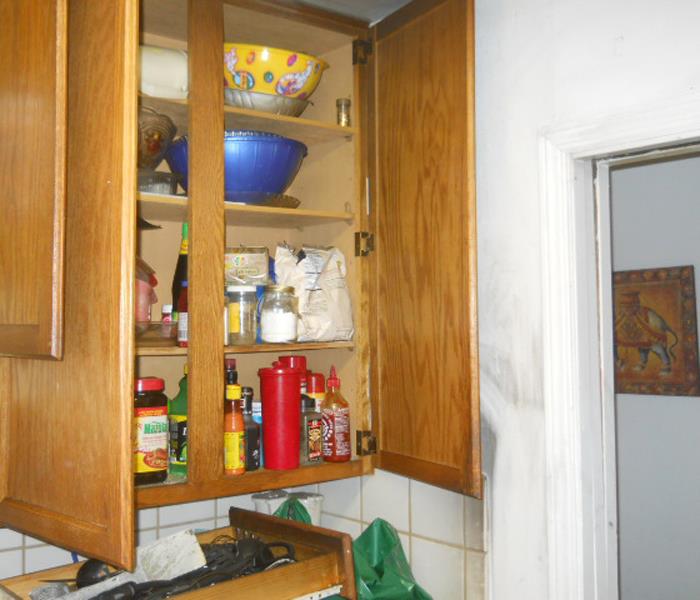Week 2 Question - Scavenger Hunt Contest Fall 2014
10/13/2014 (Permalink)
TRUE STORIES FROM THE FIELD
Imagine this, you're ready for bed and you walk into your kitchen to plug your cell phone into the charger for the night. Just a few minutes later, the smoke alarm is blaring, there's a fire in your kitchen!
This customer managed to put out the fire quickly but made a very common mistake afterwards that made the situation worse. Look carefully, can you name the mistake?
B. Opened windows for ventilation
C. Turned off HVAC system (Furnace / Air Conditioning)
D. Used soap and water to wipe down walls to prevent soot from setting
E. Ate canned food being stored on other side of the kitchen
Need a hint? "Hunt" for the answer below!
(If the links above do not work for you, you mail email your answer directly to SERVPROdave@gmail.com.)
Smoke/Soot Removal
Soot/Smoke is the product of incomplete combustion made visible by the presence of small particles of carbon. Remember, fire is indiscriminatory. Any substance which can burn, will burn! The more substances which burn, the more complex the odor. (See below)
Smoke odors normally may be classified into three categories:
1) Protein Odors: Result from burned meat, flesh, or poultry. The residue is brown/yellow in color. The residues has a greasy texture. Thorough cleaning is often required for complete deodorizing.
2) Natural Substance Odors: Result from burned wood, paper, cotton, wool, jute, cork, feathers, etc. The residue isgray/black in color and of a dry, powdered consistency.
3) Synthetic Substance Odors: Result from burned plastics, synthetic textiles, etc. The residue is black in color and smudges easily. Smoke webs are often visiblein upper corners and smoke “streamers” and are often found hanging from curtain rods, etc.
Smoke is influenced by…
1) Heat: Warmed or heated air rises and migrates to cold areas (outside walls, closets, etc.) Heat causes pores to expand.
2) Pressure: The energy created by the fire produces heat and pressure which enables the smoke to penetrate into minute cracks and crevices.
3) Impingement: Means splatter, when a substance hits a surface with sufficient velocity it will impinge (or splatter) and remain upon that surface.
4) Magnetism: Attraction of smoke to metal surfaces. (Plumbing pipes, nail heads, metal coat hangers).
5) Ionization: Opposite charges attract, forming smoke webs on structural surfaces. Plastic bags originating at the dry-cleaner’s retain static electrical charges which attract smoke. In fact, in many fire situations, more smoke residues will be found on garments protected by plastic bags, than found on unprotected garments.
After fire damage, it is natural to want to clean a home and its contents. Timely action can be a great help, but incorrect or delayed action can jeopardize or seriously impede satisfactory restoration.
DO:
- Call the fire department if there are any doubts the fire may not be completely extinguished.
- Clean and protect chrome trim on kitchen appliances with a light coating of Vaseline or other oil.
- Blow off or brush-vacuum loose smoke particles from upholstery, drapery and carpet.
- Open windows for ventilation.
- Turn off HVAC unit - blowing air through the ducts can spread ash and soot to unaffected areas
- Empty freezer and refrigerator completely if electricity is off, and prop doors open with a rolled towel or newspaper.
- Clean and protect smoked bathroom faucets, tub fittings and towel bars with light coating of oil.
- Wash plants with water on both sides of leaves (water softener helps).
- Remove children & pets (especially birds) to clean environments.
DON’T:
- Use upholstered furniture if it can be avoided.
- Use exposed food items, or canned goods which have been subjected to excessive heat.
- Use TV’s, stereos, or electrical appliances until cleaned and checked.
- Wipe or attempt to wash walls, ceilings or other absorbent surfaces.
- Send smoked garments to an ordinary dry cleaner. Improper cleaning may set smoke and odor.
Smoke residues from fires of natural origin are generally easier to clean up than fires of synthetic or protein origin. For example, it would be easier to clean up the residue from a wood or paper fire than it would to clean up the residue from a fire of synthetic or protein origin.
And remember, if water was used to put out your fire, sometimes the water damage can be worse than the fire itself! When the fire is over, most of the time the damage won’t substantially increase much over time. But if the residence is not dried out completely, the water leftover from the fire department or sprinkler will cause progressive damage increasing over time.





 24/7 Emergency Service
24/7 Emergency Service
